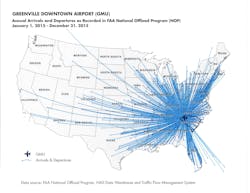Greenville Downtown Airport Lifts the Local Economy
The South Carolina Aeronautics Commission has released a Statewide Aviation System Plan and Economic Impact Report. It concludes that South Carolina’s network of 57 publicly owned airports contribute $16.3 billion annually to our state and local economies, while supporting almost 165,000 jobs.
In the findings, it was determined that last year the Greenville Downtown Airport (GMU) had the following direct and indirect/induced economic impact:
Employment: 547 (up from 453 in 2006 when last study was done)
- Payroll: $24.9 million (up from $13.4 million in 2006 when last study was done)
- Economic Activity: $68.8 million (up from $35.2 million in 2006 when last study was done)
“We all know our system of airports connects us to the world and delivers vacation spending visitors to our great cities, coastal beaches and mountain regions, but we often don’t think about the parts and products aircraft bring here, which makes many types of manufacturing and other business possible in our state,” stated Joe Frasher, South Carolina Aviation Association board member and airport director of the Greenville Downtown Airport. “A strong case could be made that without airports, Boeing and BMW would not have landed in our state. Both require parts delivered in a timely manner. Transportation by land or sea might not be quick enough in this era of just-in-time inventory,” according to Frasher.
The report notes that aviation supports about 7 percent of our state’s job market through direct employment and through companies that rely on aviation. “Almost everyone in Greenville knows someone who works at Lockheed Martin. These people would not be employed here if it weren’t for our local airports. The same can be said for all the military aviation personnel our local airports and state host,” added Frasher.
The study shows that, from various sources, airports directly generate $657 million dollars in state tax revenue. It also reports that aviation demand is expected to grow and that airports need to be maintained and funding increased to support this mode of transportation’s infrastructure. Based on previous funding history, the study determined that only 25-50 percent of the airports estimated annual needs will be available from the current state budget and the Federal Aviation Administration (FAA). The FAA can supply 90 percent of the funding needed for eligible projects at airports if state and local funds are available to fund the remaining 10 percent.
“Much like our state’s roads, our aging airports need to address deferred and ongoing maintenance like repaving cracked runways. Unlike car passengers, most airplane passengers don’t see what they are riding on. Airport managers know how to fix them but lack the funds. Also, some additional airport development will be needed in order for many counties to attract new industry. For example, most companies that use aviation want at least a 5,000-foot runway and the ability to buy fuel at airports they frequent. If an airport’s runway is shorter, but can be extended, the promise of this improvement could prove to be a critical component to site selection personnel. This can help ensure the needs of commerce are met across the state. We desperately need to repave deteriorating runways and replace older and less efficient runway and taxiway lights with more energy efficient LED fixtures,” added Frasher.
“Many businesses and vacationers arrive in South Carolina because of our strategically located airports. They leave a lot of money behind which helps grow our economy, employ our citizens and improve our overall economy. They also facilitate safe air travel for residents and visitors alike. We need our elected officials in Columbia to pass one of two bills being considered in order for us to meet our state’s annual airport maintenance and development needs,” stated Frasher in reference to S.C. Senate Bill 792 and House Bill 4700.
“The funds that are being requested through these bills are generated exclusively by our airports through airline aircraft property taxes. These funds have the power to pull into South Carolina additional FAA money to the tune of $10.00 for every $0.50 cents our state spends. These additional federal funds will boost employment and the economy somewhere. So why not here, in South Carolina?” questioned Frasher.
If Senate Bill 792 is passed into law, it would direct all airline property taxes to the State Aviation Fund. Currently, if these taxes “exceed two and one half million dollars, the revenues in excess of two and one half million dollars must be directed to the State Aviation Fund,” and this results in leaving the first two and one-half million in the State’s General Fund. (http://www.scstatehouse.gov/billsearch.php?billnumbers=792)
If House Bill 4700 is passed into law, it too would direct all airline property taxes to the State Aviation Fund. This bill would take effect over a two year period instead of the one year impact specified in the companion Senate Bill 792. (http://www.scstatehouse.gov/billsearch.php?billnumbers=4700)
“We are excited to share the study results and pleased to see that our airport, after almost 90 years in public service, continues to strongly support and bring economic development into our community,” said Frasher.
